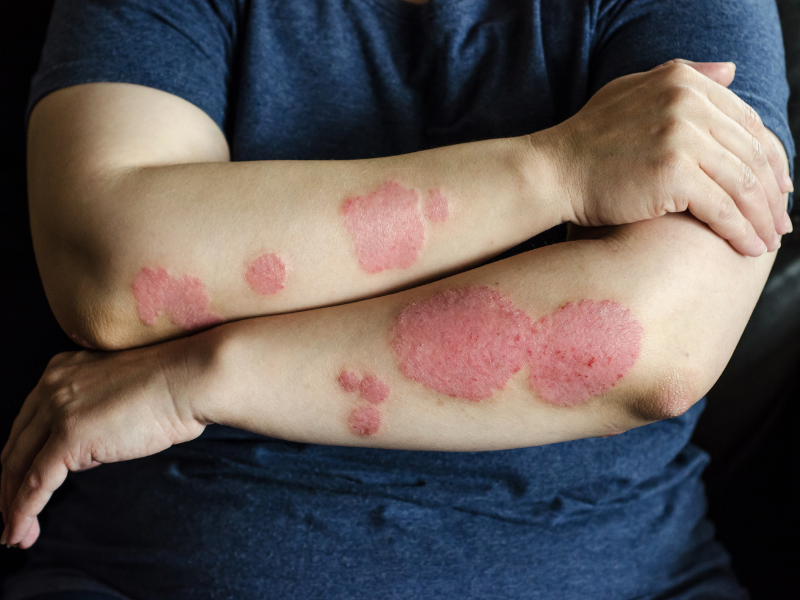Skin Allergies: A Comprehensive Guide to Types, Causes, Symptoms, Treatment, Triggers, and Risk Factors

Dealing with bumpy, red, and itchy skin is not just unpleasant. It may also be physically and socially draining. Rashes are caused by a range of factors. These factors ranges from bad encounters with certain plants to undesirable reactions to foods or medications. Hives and eczema are two of the most common types of skin rashes.
Types of Skin Allergies
Skin allergies come in different forms, each with its unique characteristics:
- Atopic Dermatitis (Eczema): It is characterized by red, inflamed patches. These patches are frequently accompanied by intense itching. This condition predominantly surfaces during childhood.
- Urticaria (Hives): Urticaria, also known as hives, presents an intriguing facet of skin allergies. These raised, itchy welts materialize as a response to histamine release. It is often precipitated by an allergic trigger. Unlike other skin allergies, hives tend to be transient, appearing and subsiding rapidly.
- Allergic Contact Dermatitis: This form of allergy materializes through direct contact with irritants such as:
- Metals
- Fragrances
- Latex
Symptoms involve localized inflammation, manifesting as redness, swelling, and pruritus.
- Irritant Contact Dermatitis: Unlike allergic contact dermatitis, this occurs due to direct contact with irritants. Chemical substances and harsh detergents can compromise the skin’s protective barrier. This trigger this form of reaction.
- Photoallergic Dermatitis: This condition arises when certain substances, found in topical medications or skin care products, undergo photochemical reactions upon exposure to sunlight. The ensuing skin response mirrors a sunburn-like reaction, complete with redness, itching, and blistering.
Causes and Risk Factors of Skin Allergies
Understanding the root causes and risk factors of skin allergies empowers us to take preventative measures:
- Immune System Response: Skin allergies occur when the immune system reacts excessively to perceived threats.
- Allergenic Substances: Everyday items like fabrics, cosmetics, and cleaning products can trigger allergies.
- Genetic Predisposition: A family history of allergies increases susceptibility.
- Environmental Factors: Exposure to irritants heightens the risk of developing skin allergies.
Common Symptoms of Skin Allergies
Recognizing the symptoms of skin allergies aids in early identification and management:
- Redness and Itchiness: Rashes resembling hives or eczema are often itchy and red.
- Swelling and Inflammation: Allergic reactions may cause swelling and inflammation in affected areas.
- Blistering: Blisters can form, causing discomfort and pain.
- Severity Variation: Symptoms can range from mild itching to severe pain. This depends on the sensitivity and allergen potency.
Treatment and Management for Skin Allergies
Thankfully, effective treatments and strategies are available to address skin allergies:
- Identifying and Avoiding Allergens: Dermatologists conduct patch tests to pinpoint triggers, enabling avoidance.
- Skincare Routines: Gentle, hypoallergenic products maintain healthy skin and prevent flare-ups.
- Over-the-Counter Antihistamines: These provide relief from itching and discomfort during acute reactions.
- Prescription Creams: Corticosteroid creams reduce inflammation in moderate to severe cases.
- Emollients and Moisturizers: These restore the skin’s barrier function. Thus, reducing the frequency and intensity of flare-ups.
- Antibiotics: Infection resulting from scratching may require antibiotics.
- Immunomodulators: Calcineurin inhibitors offer an alternative to corticosteroids for long-term management.
Preventive Measures and Trigger Avoidance
Proactive measures play a key role in minimizing skin allergies:
- Protective Clothing: Gloves, long sleeves, and other protective gear shield against allergens.
- Hypoallergenic Products: Opt for products devoid of harsh chemicals and fragrances.
- Broad-Spectrum Sunscreen: Essential for individuals prone to photoallergic reactions.
- Regular Moisturizing: Maintains the skin’s barrier function, reducing its susceptibility to allergens.
Positive Outlook When Dealing with Skin Allergies
A positive mindset is essential when dealing with skin allergies:
- Empowerment through Knowledge: Understanding skin allergies allows for informed decision-making.
- Advancements in Medical Science: Effective treatments and management strategies are available to mitigate the impact of skin allergies.
- Confidence and Grace: By embracing a positive outlook and practicing preventive measures, individuals can navigate skin allergies with confidence and grace.
Skin allergies need not be a cause for despair. Armed with knowledge about types, causes, symptoms, treatment, triggers, and risk factors, you can take control of your skin health. By maintaining a positive perspective and following recommended strategies, we can ensure that skin remains a steadfast guardian of our overall well-being.



